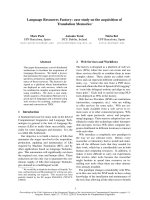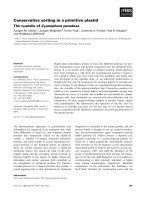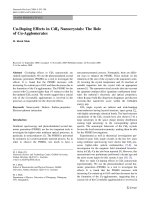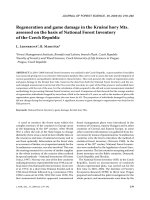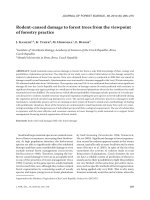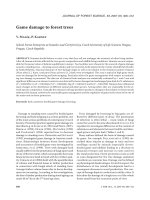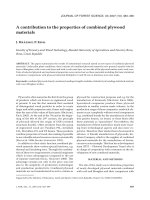Báo cáo lâm nghiệp: "Rodent-caused damage to forest trees from the viewpoint of forestry practice" potx
Bạn đang xem bản rút gọn của tài liệu. Xem và tải ngay bản đầy đủ của tài liệu tại đây (265.84 KB, 6 trang )
J. FOR. SCI., 56, 2010 (6): 265–270 265
JOURNAL OF FOREST SCIENCE, 56, 2010 (6): 265–270
Small and large mammal species are natural mem-
bers of forest ecosystems, increasing their biodiver-
sity. At high population densities, the herbivorous
species are able to significantly affect the inhabited
biotopes and thus cause considerable damage or even
exclude normal forest management (A,
MN 1998). erefore, keeping the her-
bivore-caused damage to trees at an acceptable level
is one of the priorities of forest management (G
1992). Contrary to the game species, small mammals
receive much less care, although they reduce natural
forest regeneration by consuming seeds of woody
species and injure young trees in forest plantations
by bark browsing (S 1996; N,
H 2003). Significant damage to forest regenera-
tion caused by rodents appears mainly in the winter
season, typically only at some localities and in some
years (B et al. 2005). In spite of the fact that
sometimes the activity of rodents leads to total
destruction of plantations, Czech foresters do not
yet have a reliable system of prediction of threat to
stands and so their possibilities to fight this problem
are very limited. At the same time, preventive meas-
ures, such as specific methods of forest regeneration,
are being applied only very little. at is why many
foresters anxiously await the end of winter when the
Supported by the Ministry of Agriculture of the Czech Republic, Project No. QH72075.
Rodent-caused damage to forest trees from the viewpoint
of forestry practice
J. K
1,2
, K. T
2
, M. H
1
, E. B
2
1
Institute of Vertebrate Biology, Academy of Sciences of the Czech Republic, Brno,
Czech Republic
2
Mendel University in Brno, Brno, Czech Republic
ABSTRACT: Small mammals cause serious damage to forests but there is only little knowledge of their ecology and
possibilities of plantation protection. e objective of our study was to collect information on the damage caused by
rodents to plantations of forest tree species. Data were obtained from a survey conducted in 2008 that was aimed at
damage caused by small mammals. Questionnaires were sent mostly to foresters engaged in the Lesy CR state enterprise.
We obtained usable data from 316 foresters. e response rate was 81%. It was confirmed that rodents cause significant
damage all over the Czech Republic and that the occurrence of damage cannot be easily predicted with certainty as
significant damage may appear perhaps in a small part of the threatened plantations where the key conditions for small
mammals have been fulfilled. e main factors which affected probability of damage include: presence of a woody spe-
cies attractive to rodents; suitable structure of ground vegetation enabling the pest species to breed sufficiently during
the vegetation period; and also long-lasting snow cover. e current approach of forestry practice to damage by small
mammals is considerably passive and we are missing an alert system of threat to stands and a methodology of dealing
with problematic situations. Most of the foresters are uninterested in small mammals and many have only very smat-
tering knowledge of the dangerousness of individual species and their ecological requirements. e use of rodenticides
is expensive and the most effective and economic measure to lower damage by small mammals is to support forest
management favouring natural regeneration of forest stands.
Keywords: bank vole; bark damage; field vole; forest damage
266 J. FOR. SCI., 56, 2010 (6): 265–270
extent of damage to plantations becomes apparent,
being unable to defend against this harmful factor.
One of the reasons for this passive approach to deal-
ing with damage caused by small mammals is certain
underestimation of its seriousness on the basis of
past experiences. At places that had been planted
mainly with conifers, small mammals really caused
only minor damage as they find conifers (especially
spruce) only little attractive (H, P 1992).
In recent years, however, the share of broadleaved
tree species in plantations has increased and one of
the outcomes of this management is severe rodent-
caused damage at many localities. It is therefore an
important task of this time to find some reliable
measures that will allow the successful protection
of broadleaved species, not only due to the extent of
economic losses, but also in order to ensure a suffi-
cient share of broadleaves in stands, which is a basic
prerequisite for the future of healthy forests in our
landscape (A, MN 1998).
e severity of damage to forests caused by small
mammals and the incompleteness of knowledge of
their ecology and feeding behaviour have lead us
to initiation of an extensive research focused on
monitoring the population dynamics of rodents in
forest environment, their feeding behaviour and the
damage they cause. At the beginning of the research,
we conducted a survey among foresters in the form
of a questionnaire with the aim to find out how they
perceive the significance of rodent-caused damage,
what the main characteristics of the affected stands
are like and what methods of plantation protection
are used in practice. e objective of our study was
to collect information on the damage caused by ro-
dents to plantations of forest tree species, to learn
about the practical knowledge of foresters related
to this problem and to evaluate their positive and
negative experiences on the scale of the whole Czech
Republic.
MATERIAL AND METHODS
Data were obtained from a survey conducted in
2008 that was aimed at damage caused by small
mammals. Questionnaires were sent mostly to for-
esters engaged in the Lesy CR state enterprise. Ques-
tionnaires were constructed and administered using
instructions for a total-design method (D
1978) and followed guides used in similar studies
dealing with free living herbivores (C 1998;
G et al. 2002). 390 questionnaires in total
were mailed to 78 forest divisions of the Lesy CR
state enterprise. Foresters were asked to complete
the questionnaire and to return it to our office. e
questionnaire was designed to collect any important
information from foresters on the importance of
rodents in forests and on factors affecting damage.
Twenty-three questions were divided into three
sections:
(1) Area description. Information about locality, el
-
evation above sea level and forest composition.
(2) Severity of damage caused by small mammals.
In this section we asked for information on the
extent of damage in the locality, if the damage
caused by small mammals is below, near, or above
the damage caused by wind, snow, insects and
large herbivores, on endangered tree species,
age of the most damaged trees, prevalent type
of damage and characteristics of vegetation of
severely damaged plots.
(3) Control of damage caused by small mammals.
Information gathered in this section regarded
methods for a reduction of damage caused by
small mammals. Foresters were asked to indicate
which species of small mammals were present in
their area, if they had experiences in the control
of damage and for each control method we asked
for its evaluation.
RESULTS AND DISCUSSION
We obtained usable data from 316 foresters. e
response rate was 81%. Rodents cause significant
damage all over the Czech Republic and almost
every forest district reported the occurrence of se-
vere as well as mild damage over the years. For 35%
of the addressed foresters, damage caused by small
mammals is virtually unknown and the economic
loss is insignificant. Other 50% of the respondents
find the damage bearable, without a serious impact
on their management. Only for 15% of foresters the
rodent-caused damage represents a serious problem
threatening their management. is corresponds to
the comparison of damage caused by rodents and
damage due to other harmful factors. Most of the
foresters (over 80%) regard the damage by small
mammals as less serious than that caused by abiotic
factors, bark beetles and herbivorous game. e
results show that the occurrence of rodent-caused
damage depends on the coincidence of several fac-
tors in a specific area at a specific time (S
et al. 1993). e occurrence of damage cannot be
predicted with certainty as significant damage may
appear perhaps at a small part of the threatened
plantations where the key conditions have been ful-
filled. ose conditions include: presence of a woody
species attractive to rodents (H, P 1992);
suitable structure of ground vegetation enabling the
J. FOR. SCI., 56, 2010 (6): 265–270 267
pest species to breed sufficiently during the vegeta-
tion period (H 2002); and also long-lasting
snow cover (B et al. 2005). High abundance of
pest species is not the cause of damage at localities
not suitable for small mammals (for example due to
the lack of herbaceous cover) or at localities where
rodents can use alternative attractive food sources
(H 2002).
No relationship was found between the intensity
of threat to woody species by small mammals and
altitude of the locality (P > 0.05). Only in the areas
at the altitude of 600–700 m a.s.l. the rodent-caused
damage was lower than at other localities (P < 0.05).
A common characteristic of the little threatened
localities is a high share of coniferous species both
in the parent stands and in plantations. Evidently
less threatened are the plantations of coniferous
species than those of broadleaves. Significant differ-
ences were found between the damage suffered by
individual tree species. Rowan, beech and Douglas
fir were affected the most; alder, spruce and pine the
least (Fig. 1). Only minor damage appears in beech
plantations at lower altitudes where the stands are
reproduced purely by a shelterwood system with the
use of natural regeneration and thus the herbaceous
cover does not fully develop here. e intensity of
damage to individual tree species corresponds to
the need of repair planting in plantations that were
totally destroyed by rodents. In the case of beech it
was necessary to repeat reforestation in 6% of the
planted area on average due to rodents, while in
other tree species it was several times less (Fig. 1).
Differences in damage between tree species are due
to differences in feeding attractiveness (H,
P 1992).
Significant differences in the intensity of damage
to trees at clearings were found in dependence on
the structure of the herbaceous cover. According to
foresters, the clearings free of ground vegetation or
covered only with dicotyledonous herbs were threat-
ened only little, while the clearings with forest weeds
were threatened five times more and those covered
with grasses approx. 12 times more. e role of the
herb layer is also reflected in the situation on fertile
soils where the damage is four times more frequent
than on poor soils. ese findings are in agreement
with results of several studies which documented
the importance of the herb layer for small mammal
populations (S, S 2001; S
et al. 2005).
e foresters were also asked which small mam-
mal species participated in browsing. It turned out
that more than a half of them do not pay attention
to small mammals or cannot determine the species
and so they are unable to specify which of them
contribute to the damage. Among the species clas-
sified as pests, the most frequent was the bank vole
as a typical forest species while the field vole and
common vole are much less harmful according to
the foresters. However, this opinion concerning the
significance of the individual species is in contradic-
tion with the information the foresters provided on
the distribution of damage which is the greatest on
grass-covered clearings (Fig. 2), i.e. a biotope suit-
able mainly for field and common voles (K,
S 2003). Both species are able to inhabit the
0
5
10
15
20
25
rowan
beech
douglas fir
red ash
maple
oak
lime
larch
fir
goat willow
pine
spruce
Area (%)
Tree species
repeated reforestation (% stands)
damage (% stands)
repeated reforestation (% stands)
damage (% stands)
repeated reforestation (% stands)
damage (% stands)
Fig. 1. Extent of damage by small mammals and repeated reforestation (% stands) in relation to individual tree species
Area (%)
268 J. FOR. SCI., 56, 2010 (6): 265–270
grassy clearcut areas very well and to drive the bank
vole out of there. e survey revealed underestima-
tion of the significance of rodents’ (especially com-
mon vole’s) impact on forest woody species as well as
considerable gaps in the foresters’ knowledge of the
ecology of small mammals. Another question was
which year since 2000 had been the worst as regards
the rodent-caused damage (Fig. 3). Yet it turned out
that even at close localities, rodent-caused damage
may emerge in different years, indicating that the
population dynamics of rodents is not synchronized.
Forest Protection Service (FPS) reports the most
serious damage to plantations caused by small mam-
mals in 2000, 2001 and 2005. We can only speculate
why the data from the survey and from FPS differ
so fundamentally. One of the possible explanations
is a certain delay in damage detection as it is not
often clearly visible in spring when the affected trees
flush, but only during summer when they gradually
die back. Six foresters pointed out snow cover as
the most significant environmental factor, markedly
increasing the risk of damage.
Possible preventive steps against damage
caused by small mammals to plantations
Seven questions in the survey dealt with the pro-
tection of plantations against small mammals. Ap-
proximately a half of the respondents stated that they
were not aware of any effective way of protection
while the other half thought that the protection of
plantations was possible. e foresters also expressed
their opinions concerning the effectiveness of eight
suggested methods of protection; surprisingly, the
highest number of them (26%) found it effective to
install bird boxes for owls and birds of prey and the
second place was taken by the treatment of threat-
ened areas with rodenticides (23%) (Fig. 4). As for
the most common application of rodenticides, only a
small part (12%) of the responding foresters regarded
this method as trouble-free and well effective; 65% of
them found rodenticides effective, but with limited
applicability due to their relation to environment and
price. More than a half of the foresters concluded
that the existing possibilities of plantation protec-
Fig. 2. Distribution of damage according
to the composition of the herb layer
Fig. 3. Extent of damage by small mam-
mals to all tree species in the last four
years (% stands)
210
240
d
s
0
30
60
90
120
150
180
r
equence of damaged stan
d
grasses bramble and
raspberry
undergrowth
forbs without herb
layer
F
r
Main compnent of herb layer
Main component of herb layer
Frequence od damaged stands
80
100
20
40
60
80
e
nt of damage (% stands)
0
2000 2003 2005 2007
Ext
e
Year
80
100
20
40
60
80
e
nt of damage (% stands)
0
2000 2003 2005 2007
Ext
e
Year
J. FOR. SCI., 56, 2010 (6): 265–270 269
tion against rodent-caused damage did not satisfy
the needs of forestry practice. Nevertheless, 58% of
the responding foresters used rodenticides at least
occasionally and 2.5% of broadleaved and 0.2% of
coniferous plantations were treated with rodenti-
cides annually at the monitored localities. Despite
the costs of rodenticides, only 7% of the foresters
monitored the abundance of small mammals. e
rest of them decided on the application of rodenti-
cides or other protective measures on the basis of
other signs. As much as 80% of the foresters thought
that rodent-caused damage could be reduced by
appropriate forest management methods and they
provided many examples. e most frequent was a
suggestion to support forest management favouring
natural regeneration which seems to be the most
effective and economic measure to lower damage
by small mammals (S, S 2001; H-
, P 2003; M et al. 2004). A reduction
of the herb layer on the clearings is also regarded as
a practical tool helping to reduce damage caused by
small mammals. erefore, another possibility is to
carry out regeneration cuttings on smaller plots in
order to prevent the growth of herbal vegetation, or
even to perform total elimination of forest weeds
by herbicides. According to the foresters, predators
could also play an important role in the control of ro-
dents and should be supported. ey recommended
clearing away the brushwood so that it would not
serve as shelter for small mammals, installing bird
nesting boxes and some even suggested a ban on
hunting foxes in forests in order to increase the
predator pressure on small mammals.
CONCLUSIONS
e survey among foresters has confirmed that at
some localities the damage caused by small mam-
mals indeed presents a significant problem for the
regeneration of broadleaved tree species. At the
same time it is evident that at many places such
damage does not appear at all for different reasons.
However, the current approach of forestry practice
to this damage is considerably passive and we lack
an alert system of threat to stands and a methodol-
ogy of dealing with problematic situations. Most
of the foresters are uninterested in small mammals
and many have only a very smattering knowledge of
the dangerousness of individual species and their
ecological requirements. at is why the partial in-
formation on the possibilities of damage prevention
is only of empirical character and does not allow
generalization. Further research in this field is nec-
essary to provide well-founded information on the
methods for signalling the threat to stands and pos-
sibilities how to defend against the damage caused
by small mammals.
R efer e nce s
A D.J., MN S.J. (1998): Ungulate effects
on the functional species composition of plant communi-
infections
2%
trapping of small
l
mamma
l
s
3%
elimination of herb
layer
14%
repellents
13%
elimination of
bird boxes
26%
elimination of
attractive species
3%
natural regeneration
of stands
16%
rodenticides
23%
16%
Fig. 4. Methods to lower damage by small mammals according to foresters’ opinions
270 J. FOR. SCI., 56, 2010 (6): 265–270
ties: Herbivore selectivity and plant tolerance. Journal of
Wildlife Management, 62: 4.
B O., D C., R P. (2005): And if we
talked about rodent damage. Rendl Vous Techniques, 7:
46–50.
C M.R. (1998): Perceptions of American agricultural
producers about wildlife on their farms and ranches. Wild-
life Society Bulletin, 26: 597–604.
D, D.A. (1978): Mail and telephone surveys: the total
design method. New York, John Eley and Sons.
G M., S F., G S. (2002): Farmers’
attitudes toward the carrying out of wildlife habitat im-
provement actions (WHIA) in intensive agricultural areas
of Northern Italy. Zeitschrift für Jagdwissenschaft, 48:
309–319.
G R.M.A. (1992): A review of damage by mammals in north
temperate forests: 1. Deer. Forestry, 65: 145–169.
H L. (2002): Consumption of bark and seeds by voles
in relation to habitat and landscape structure. Scandinavian
Journal of Forest Research, 17: 28–34.
H T., P H.J. (2003): Abwehr von mäuseschäden.
Allgemeine Forstzeitschrift der Wald, 21: 1076–1078.
H J., P T. (1992): Selection of deciduous trees by
free ranging voles and hares in relation to plant chemistry.
Oikos, 63: 477–484.
K W., S T.P. (2003): Partial and clear-cut
harvesting of high-elevation spruce-fir forests: implications
for small mammal communities. Canadian Journal of Forest
Research, 33: 2283–2296.
M G., D V., S M. (2004): Zertifi-
zierung und waldschutz gegen mause. Forst und Holz, 59:
178–182.
N H., H R. (2003): Zur forstlichen Bedeutung
von Wuhlmausen in Erstaufforstungen Osthosteins. Forst
und Holz, 5 8: 26–31.
S M. (1996): Aktuelles zur Mäusebekämpfung.
Allgemeine Forstzeitschrift der Wald, 6: 315–318.
S T.P., C H., J L.A., D P.K. (1993):
Influence of feeding damage by small mammals on tree
growth and wood quality in young lodgepole pine. Canadian
Journal of Forest Research, 23: 799–809.
S T.P., S D.S. (2001): Influence of variable
retention harvests on forest ecosystems. II. Diversity and
population dynamics of small mammals. Journal of Applied
Ecology, 38: 1234–1252.
S T.P., S D.S., L P.M.F., R
D.B. (2005): Long-term responses of ecosystem components
to stand thinning in young lodgepole pine forest – II. Diver-
sity and population dynamics of forest floor small mammals.
Forest Ecology and Management, 205: 1–14.
Received for publication June 17, 2009
Accepted after corrections February 19, 2010
Corresponding author:
Doc. Ing. J K, Ph.D., Mendelova univerzita v Brně, Lesnická a dřevařská fakulta, Zemědělská 3,
613 00, Brno, Česká republika
tel.: + 420 545 134 539, fax: + 420 545 134 529, e-mail:
